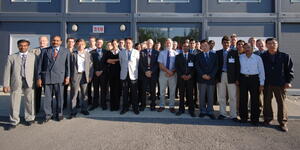Design check for cooling water systems
The conceptual design review of ITER's component cooling water system, the chilled water system, and the heat rejection system was completed this week in Cadarache. The review was performed together with representatives from the Domestic Agencies in the US and in India, and experts from the international power producing industry of India and the ITER Organization. All three cooling systems will be supplied by the Indian Domestic Agency. The component cooling water system (CCWS) will manage the heat rejected from the Tokamak cooling water system (TCWS), and the heat rejection system (HRS) rejects this heat to the atmosphere. The TCWS is used to remove the heat from the vacuum vessel and its internal components of the blanket and diverter. The chilled water system (CHWS) has two functions. One main function is to provide normal cooling to building HVAC units. Its other main function is to remove heat from safety-important components including heat removal from the vacuum vessel during loss of offsite power events using dedicated chiller package units that reject this heat directly to the atmosphere.
Alan Kaye, former Chief Engineer at JET and now Chairman of the design review panel, indicates that the challenges of ITER's cooling water system lie not only in its sheer size—with a volume of 20,000 cubic metres, the cooling water basin will have the volume of about eight Olympic-size swimming pools—but also in its heat removing capacity. "During a Tokamak plasma pulse of 500 seconds duration, the water temperature in the basin could rise by 5 degrees Celsius," Kaye explains. "We have to remove a peak power 1200 MW of heat energy during one pulse," explains Kaye. "That is very near to the number you deal with in a commercial power plant."
The conceptual design review for the cooling water systems is the first step of a three-step process that will define the specifications and requirements enabling the issue of the Procurement Arrangement for the in-kind procurement of the system's components. The incorporation of design improvements identified during the conceptual design review and approval of their implementation by the ITER management will permit proceeding to the next step, the preliminary design, and will also permit the Indian Domestic Agency to issue contracts for their in-kind procurement equipment and components. The final step will then be the final design review giving all the necessary details to start with manufacturing.
But back to step number one—during the two-day meeting a number of design problems referred to as "chits" were raised which now have to be solved before the ITER Cooling Water Section moves to step number two scheduled for next year.


